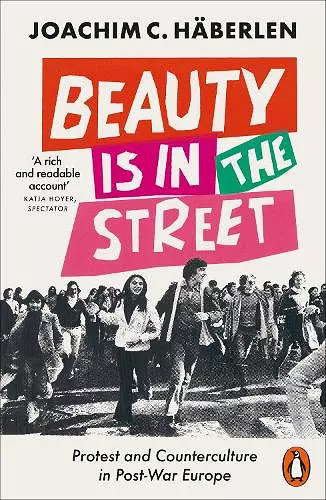Beauty is in the Street
Protest and Counterculture in Post-War Europe
Format:Paperback
Publisher:Penguin Books Ltd
Published:3rd Oct '24
Should be back in stock very soon
This paperback is available in another edition too:
- Hardback£35.00(9780241479377)

'A rich and readable accountof left-wing activism in the West and opposition to Soviet-style communism in the East' Katja Hoyer, The Spectator
'A dream, perhaps, but one that still sounds worth fighting for, even beautiful' Stuart Jeffries, The Observer
'Anambitious and masterly accountof utopian protest in Europe ... Fast-paced, with an eye for telling detail and written with a light touch' Robert Gildea
In post-war Europe, protest was everywhere. On both sides of the Iron Curtain, from Paris to Prague, Milan to Wroclaw, ordinary people took to the streets, fighting for a better world. Their efforts came to a head most dramatically in 1968 and 1989, when mass movements swept Europe and rewrote its history.
In the decades between, Joachim C. Häberlen argues, new movements emerged that transformed the nature of protesting. Activism moved beyond traditional demonstrations, from squatting to staging 'happenings' and camping out at nuclear power plants. People protested in the way they dressed, the music they listened to, the lovers they slept with, the clubs where they danced all night. New movements were born, notably anti-racism, women's liberation, gay liberation, and environmentalism. And protest turned inward, as activists experimented with new ways of living and feeling, from communes to group therapy, in their efforts to live a better life in the here and now.
Some of these struggles succeeded, others failed. But successful or not, their history provides a glimpse into roads not taken, into futures that did not happen. The stories in Häberlen's book invite us to imagine different futures; to struggle, to fail, and to try again. In a time when we are told that there are no alternatives, they show us that there could be another way.
Well written and informative ... The stories of Provo and other groups, less mythologised than the brick-throwers of 1968 but equally important, illuminate the pages of this book, showing that their efforts 'changed the society in which we live' not merely by achieving things, but also by encouraging us to try it ourselves. -- Anna Aslanyan * Financial Times *
[Haeberlen's] particular strength is in covering not just protests in the West, such as the 1968 movements, but on the other side of the Iron Curtain ... intricate details ... a rich and readable account of left-wing activism in the West and opposition to Soviet-style communism in the East. -- Katja Hoyer * The Spectator *
An amiable history of countercultural agitators, from Amsterdam’s anti-car anarchists to Poland’s ‘revolution of dwarfs’, shows the myriad faces of postwar dissent ... A dream, perhaps, but one that still sounds worth fighting for, even beautiful. -- Stuart Jeffries * The Observer *
Although Europe had the uprisings in Paris and Prague in 1968, the revolutionary violence of the 1970s and theorists such as Herbert Marcuse and Guy Debord, the counter-culture it produced tends to take second place in the Anglophone world’s imagination. Joachim C. Häberlen’s wide-ranging book gives the continent its due. -- Dorian Lynskey * Literary Review *
An engaging book with many fascinating details... which reminds us thatrevolution and counter-revolution are not the only possible outcomes in history -- Jan Werner Müller * Foreign Policy *
An ambitious and masterly account of utopian protest in Europe from the 1950s to 1989 and beyond, ranging from political revolt to environmental and humanitarian movements and the sexual revolutions, lifestyle changes, music and laughter of the counterculture. Fast-paced, with an eye for telling detail and written with a light touch. -- Robert Gildea
Vibrant ... a book that pulses with colour and light ... vividly demonstrates that the post-war impulse to build a better world was so much more than mere theory. -- Marcus Colla * The Interpreter *
A fascinating book -- Terence Renaud * Jacobin *
ISBN: 9780141994963
Dimensions: 197mm x 131mm x 23mm
Weight: 351g
512 pages